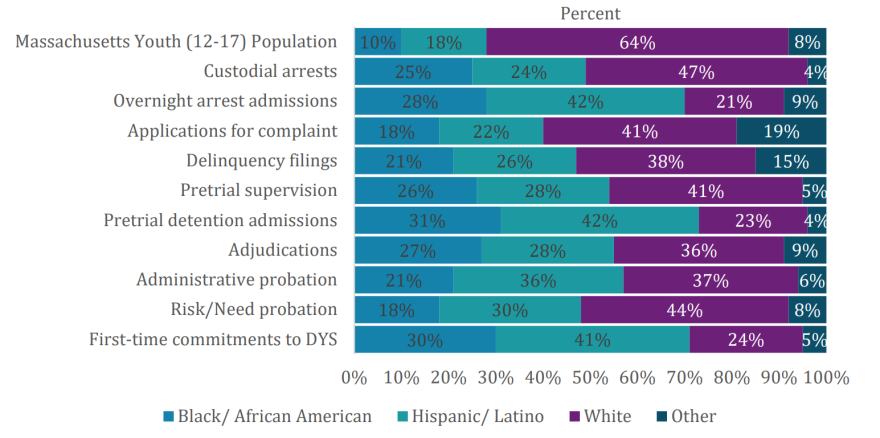Overall, fewer minors are coming into contact with the Massachusetts juvenile justice system. But there is great disparity when you look at the data by race and ethnicity. That's according to a new report from the Massachusetts Juvenile Justice Policy and Data Board.
Melissa Threadgill is director of strategic innovation in the state's Office of the Child Advocate. She explained how youth of color, in particular, could benefit from diversion programs.
Melissa Threadgill, Office of the Child Advocate: As you said, we did find good news in this report, which is that we continue to see fewer youth entering and moving through our juvenile justice system. And this continues a trend well over a decade. And that is true for both white youth and Black and Latino youth. Overall, we do see numbers going down.
At the same time, we continue to see really significant disparities in our juvenile justice system, which basically means that Black and Latino youth are overrepresented in our system. And so, what we found is that even though the numbers are going down and that's a good thing, there are still a lot of opportunities for us to divert more youth from the justice system earlier in the process, and in particular to increase diversion for Black and Latino youth.
Carrie Healy, NEPM: I'm curious about the diversionary programs available. Did they get impacted by the coronavirus? Did that impact the quality of the report or the programs available?
The issues around diversion, I think, are longer standing and existed before the pandemic. Absolutely, programs across the state were impacted by the pandemic. These programs are usually in person. They often involve youth enrichment activities, and we know that when everything moved virtual, a lot of those programs were impacted. That said, what we've seen across the commonwealth is actors in the system — police officers, district attorneys and judges — all have the legal option to divert a youth, and we've seen increased willingness to use that option over time.
What we'd like to see is increased availability across the state of really high-quality diversion programs that meet the needs of these kids, so they don't come back to the system. And also, that police and [district attorneys] and judges feel really confident and sending kids to these programs, because they know they're likely to get good results.
Speaking about across the state, one point made in the report is that there's a variation in the use of case dismissals. That specifically impacts Hampden County a lot more than other regions in the state. Can you talk specifically about that data?
There are a lot of variations in the juvenile justice system, and that's because individual actors in the system have the authority to make different decisions. So law enforcement live in different communities and are responsive to the needs and desires of different communities. District attorneys are elected by the local communities, and some of them make decisions differently about which cases to prosecute, and which cases to divert. And similarly, although judges are not elected in Massachusetts, once they're appointed, they do have pretty broad leeway to make these decisions, and so we see these variations across the state.
We do say when we look at data in Hampden County that they dismiss a lower percentage of their filing compared to other counties. And at the same time, we see that these counties have lower rates of diversion prior to arraignment.
And we suspect that this might indicate that there could be increased opportunities for pre-arraignment diversion in Hampden County. At the same time, we do know that different counties have different kinds of cases that come to the court, and we do tend to see sometimes more serious cases coming to the attention of the court in Hampden County — weapons cases, for example. And so that variation can be explained, I think, both by system actors as well as the proportion of the cases to the court.
There’s an understanding and the data supports, kind of a persistent racial and ethnic disparity in the commonwealth's juvenile justice and child welfare systems. So how can the state begin to make the child-serving systems more equitable?
Part of disparities are societal, right? We know that Black and Latino kids are more likely to live in poverty. They're more likely to have experienced significant trauma in their lives, and they're more likely to live in neighborhoods with concentrated disadvantage. So that's going to have an impact on their behavior as they develop. But then you layer on different levels of access to the kinds of services we know that make a difference for kids. We know high-quality schools, access to enrichment activities, strong mental health support services can really make a difference for kids, and we know that Black and Latino kids have less access to these supports.
So our first job as a system is to make sure that kids across the commonwealth have access to the kinds of supports and systems that can prevent their entry to the justice system in the first place. But then finally, as a system, we have to acknowledge that we treat the misbehavior of Black and Latino youth differently than we treat the misbehavior of white youth on average.
So this behavior is common in adolescents. But the truth is, as a society, we are more likely to react to this common misbehavior of Black and Latino kids by arresting them and by putting them in pretrial detention than we are for white kids. And so, as a society and as a system, we have really got to get to the point where we see all of these kids as deserving of support, of empathy, of second chances. And the numbers show that we just aren't there yet.





